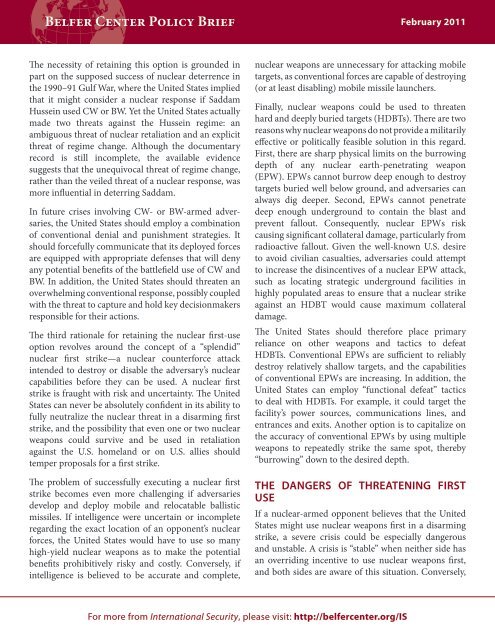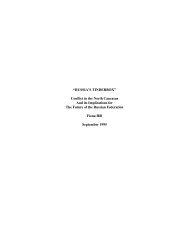The Future of U.S. Nuclear Policy: The Case for No First Use
The Future of U.S. Nuclear Policy: The Case for No First Use
The Future of U.S. Nuclear Policy: The Case for No First Use
You also want an ePaper? Increase the reach of your titles
YUMPU automatically turns print PDFs into web optimized ePapers that Google loves.
<strong>The</strong> necessity <strong>of</strong> retaining this option is grounded in<br />
part on the supposed success <strong>of</strong> nuclear deterrence in<br />
the 1990–91 Gulf War, where the United States implied<br />
that it might consider a nuclear response if Saddam<br />
Hussein used CW or BW. Yet the United States actually<br />
made two threats against the Hussein regime: an<br />
ambiguous threat <strong>of</strong> nuclear retaliation and an explicit<br />
threat <strong>of</strong> regime change. Although the documentary<br />
record is still incomplete, the available evidence<br />
suggests that the unequivocal threat <strong>of</strong> regime change,<br />
rather than the veiled threat <strong>of</strong> a nuclear response, was<br />
more influential in deterring Saddam.<br />
In future crises involving CW- or BW-armed adversaries,<br />
the United States should employ a combination<br />
<strong>of</strong> conventional denial and punishment strategies. It<br />
should <strong>for</strong>cefully communicate that its deployed <strong>for</strong>ces<br />
are equipped with appropriate defenses that will deny<br />
any potential benefits <strong>of</strong> the battlefield use <strong>of</strong> CW and<br />
BW. In addition, the United States should threaten an<br />
overwhelming conventional response, possibly coupled<br />
with the threat to capture and hold key decisionmakers<br />
responsible <strong>for</strong> their actions.<br />
<strong>The</strong> third rationale <strong>for</strong> retaining the nuclear first-use<br />
option revolves around the concept <strong>of</strong> a “splendid”<br />
nuclear first strike—a nuclear counter<strong>for</strong>ce attack<br />
intended to destroy or disable the adversary’s nuclear<br />
capabilities be<strong>for</strong>e they can be used. A nuclear first<br />
strike is fraught with risk and uncertainty. <strong>The</strong> United<br />
States can never be absolutely confident in its ability to<br />
fully neutralize the nuclear threat in a disarming first<br />
strike, and the possibility that even one or two nuclear<br />
weapons could survive and be used in retaliation<br />
against the U.S. homeland or on U.S. allies should<br />
temper proposals <strong>for</strong> a first strike.<br />
<strong>The</strong> problem <strong>of</strong> successfully executing a nuclear first<br />
strike becomes even more challenging if adversaries<br />
develop and deploy mobile and relocatable ballistic<br />
missiles. If intelligence were uncertain or incomplete<br />
regarding the exact location <strong>of</strong> an opponent’s nuclear<br />
<strong>for</strong>ces, the United States would have to use so many<br />
high-yield nuclear weapons as to make the potential<br />
benefits prohibitively risky and costly. Conversely, if<br />
intelligence is believed to be accurate and complete,<br />
For more from International Security, please visit: http://belfercenter.org/IS<br />
February 2011<br />
nuclear weapons are unnecessary <strong>for</strong> attacking mobile<br />
targets, as conventional <strong>for</strong>ces are capable <strong>of</strong> destroying<br />
(or at least disabling) mobile missile launchers.<br />
Finally, nuclear weapons could be used to threaten<br />
hard and deeply buried targets (HDBTs). <strong>The</strong>re are two<br />
reasons why nuclear weapons do not provide a militarily<br />
effective or politically feasible solution in this regard.<br />
<strong>First</strong>, there are sharp physical limits on the burrowing<br />
depth <strong>of</strong> any nuclear earth-penetrating weapon<br />
(EPW). EPWs cannot burrow deep enough to destroy<br />
targets buried well below ground, and adversaries can<br />
always dig deeper. Second, EPWs cannot penetrate<br />
deep enough underground to contain the blast and<br />
prevent fallout. Consequently, nuclear EPWs risk<br />
causing significant collateral damage, particularly from<br />
radioactive fallout. Given the well-known U.S. desire<br />
to avoid civilian casualties, adversaries could attempt<br />
to increase the disincentives <strong>of</strong> a nuclear EPW attack,<br />
such as locating strategic underground facilities in<br />
highly populated areas to ensure that a nuclear strike<br />
against an HDBT would cause maximum collateral<br />
damage.<br />
<strong>The</strong> United States should there<strong>for</strong>e place primary<br />
reliance on other weapons and tactics to defeat<br />
HDBTs. Conventional EPWs are sufficient to reliably<br />
destroy relatively shallow targets, and the capabilities<br />
<strong>of</strong> conventional EPWs are increasing. In addition, the<br />
United States can employ “functional defeat” tactics<br />
to deal with HDBTs. For example, it could target the<br />
facility’s power sources, communications lines, and<br />
entrances and exits. Another option is to capitalize on<br />
the accuracy <strong>of</strong> conventional EPWs by using multiple<br />
weapons to repeatedly strike the same spot, thereby<br />
“burrowing” down to the desired depth.<br />
THE DANGERS OF THREATENING FIRST<br />
USE<br />
If a nuclear-armed opponent believes that the United<br />
States might use nuclear weapons first in a disarming<br />
strike, a severe crisis could be especially dangerous<br />
and unstable. A crisis is “stable” when neither side has<br />
an overriding incentive to use nuclear weapons first,<br />
and both sides are aware <strong>of</strong> this situation. Conversely,
















